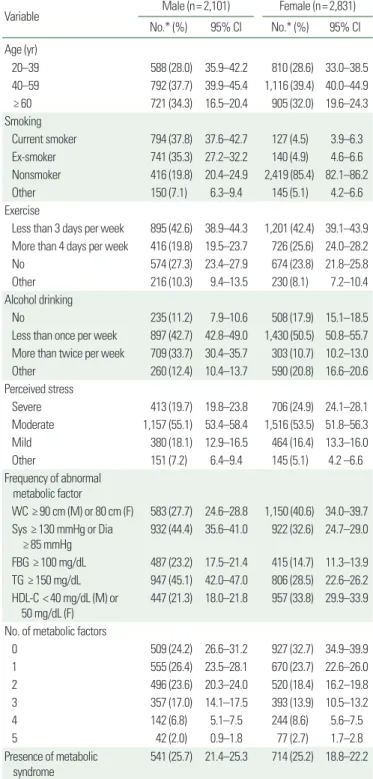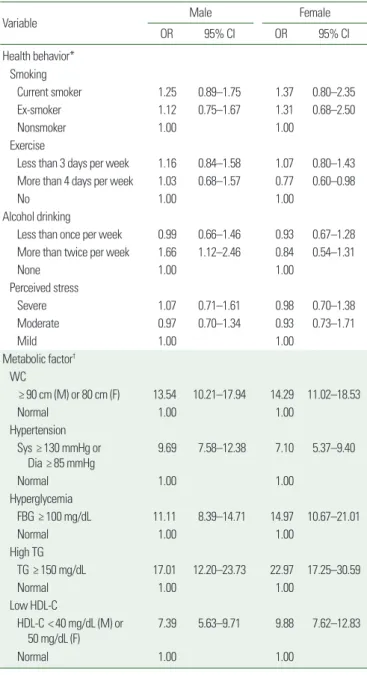Clustering Effects of Metabolic Factors and the Risk of Metabolic Syndrome
Yun-jin Kim, Hye-rim Hwang*
Department of Family Medicine, Pusan National University Hospital, Pusan National University School of Medicine, Busan, Korea
Background: Metabolic syndrome is a major risk factor for cardiovascular disease. Clustering of a combination of individual factors that increase the actual rather than the expected prevalence might be helpful in under- standing the pathophysiology of metabolic syndrome. The aim of this study was to analyze the most influential factors for metabolic syndrome to assess clustering factors of metabolic syndrome.
Methods: Subjects from the Korea National Health and Nutrition Examination Survey (KNHANES) VI were in- cluded in the present study. The status of health behaviors was obtained using the questionnaires included in the KNHANES VI. A complex, stratified, and multistage sampling design was used to analyze the data according to statistics from the Korea Centers for Disease Control and Prevention.
Results: A total of 2,101 men and 2,831 women aged older than 20 years were included in this study. In men, drinking alcohol more than twice per week was related with the prevalence of metabolic syndrome; while, in women, exercise was related with the prevalence of metabolic syndrome. The clustering effect was observed for more than three metabolic factors. In men, the clustering effect was strongest for the combination of hyperten- sion, hyperglycemia, and hypertriglyceridemia. In women, the strongest clustering effect was observed for the combination of abdominal obesity, hypertriglyceridemia, and low high-density lipoprotein cholesterol concen- tration.
Conclusion: The health behaviors affecting metabolic syndrome in men and women included drinking alco- hol more than twice a week and exercising more than four times a week, respectively; in addition, hypertriglyc- eridemia most significantly influenced the clustering effect of metabolic syndrome.
Key words: Metabolic syndrome, Hypertriglyceridemia
Received June 22, 2018 Reviewed July 17, 2018 Accepted September 6, 2018
* Corresponding author Hye-rim Hwang
https://orcid.org/0000-0001-7658-3749 Department of Family Medicine, Pusan National University Hospital, Pusan National University School of Medicine, 179 Gudeok-ro, Seo-gu, Busan 49241, Korea
Tel: +82-51-240-7834 Fax: +82-51-240-7843 E-mail: hezera83@naver.com
INTRODUCTION
Metabolic syndrome is a major risk factor for type 2 diabetes mellitus and cardiovascular disease. Specifically, it increases the risk of incidence of type 2 diabetes mellitus by 3.53- to 5.17-fold
1,2and that of the incidence of cardiovascular disease by 1.53- to 2.18- fold.
3Furthermore, metabolic syndrome increases all-cause mortal- ity by 1.27- to 1.60-fold.
4To promote public health and reduce mortality incidence, the establishment of management practices for metabolic syndrome is important. However, factors of metabolic syndrome vary according to definition, and whether metabolic
syndrome is a disease sharing a pathogenesis remains unclear.
5As a result of these limitations, there is no consistent treatment recom- mendation. To elucidate the pathophysiology of metabolic syn- drome, it could be helpful to understand the incidence differences of metabolic syndrome depending on the combination of individ- ual factors of metabolic syndrome and to clarify if there is a dis- crepancy between the expected and actual prevalence of metabolic syndrome with a certain combination of individual factors. The combination of individual factors that increases the actual preva- lence compared with the expected prevalence is defined as cluster- ing.
6Copyright © 2018 Korean Society for the Study of Obesity
This is an Open Access article distributed under the terms of the Creative Commons Attribution Non-Commercial License (http://creativecommons.org/licenses/by-nc/4.0/) which per- mits unrestricted non-commercial use, distribution, and reproduction in any medium, provided the original work is properly cited.
2017-03-16 https://crossmark-cdn.crossref.org/widget/v2.0/logos/CROSSMARK_Color_square.svg

